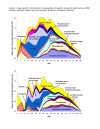Cause-specific inequalities in mortality in Scotland: two decades of change. A population-based study
- PMID: 17650304
- PMCID: PMC1939991
- DOI: 10.1186/1471-2458-7-172
Cause-specific inequalities in mortality in Scotland: two decades of change. A population-based study
Abstract
Background: Socioeconomic inequalities in mortality have increased in recent years in many countries. We examined age-, sex-, and cause-specific mortality rates for social groups in and regions of Scotland to understand the patterning of inequalities and the causes contributing to these inequalities.
Methods: We used death records for 1980-82, 1991-92 and 2000-02 together with mid-year population estimates for 1981, 1991 and 2001 covering the whole of Scotland to calculate directly standardised mortality rates. Deaths and populations were coded to small areas (postcode sectors and data zones), and deprivation was assessed using area based measures (Carstairs scores and the Scottish Index of Multiple Deprivation). We measured inequalities using rate ratios and the Slope Index of Inequality (SII).
Results: Substantial overall decreases in mortality rates disguised increases for men aged 15-44 and little change for women at the same ages. The pattern at these ages was mostly attributable to increases in suicides and deaths related to the use of alcohol and drugs. Under 65 a 49% fall in the mortality of men in the least deprived areas contrasted with a fall of just 2% in the most deprived. There were substantial increases in the social gradients for most causes of death. Excess male mortality in the Clydeside region was largely confined to more deprived areas, whilst for women in the region mortality was in line with the Scottish experience. Relative inequalities for men and women were greatest between the ages of 30 and 49.
Conclusion: General reductions in mortality in the major causes of death (ischaemic heart disease, malignant neoplasms) are encouraging; however, such reductions were socially patterned. Relative inequalities in mortality have increased and are greatest among younger adults where deaths related to unfavourable lifestyles call for direct social policies to address poverty.
References
-
- Jha P, Peto R, Zatonski W, Boreham J, Jarvis MJ, Lopez AD. Social inequalities in male mortality, and in male mortality from smoking: indirect estimation from national death rates in England and Wales, Poland, and North America. Lancet. 2006;368:367–370. doi: 10.1016/S0140-6736(06)68975-7. - DOI - PubMed
Publication types
MeSH terms
Grants and funding
LinkOut - more resources
Full Text Sources
Miscellaneous


